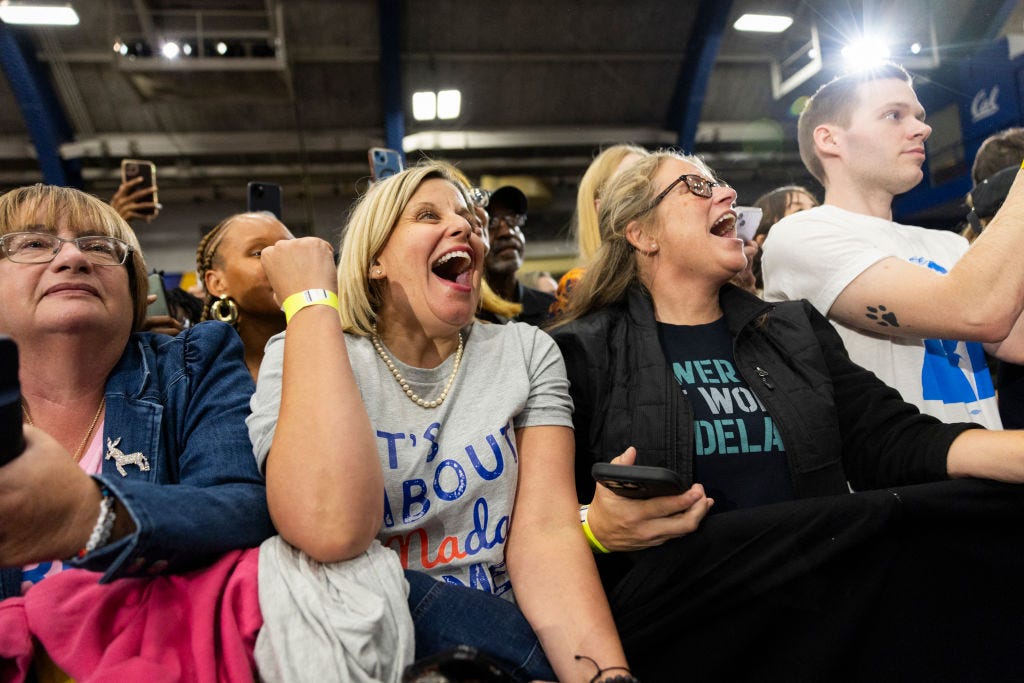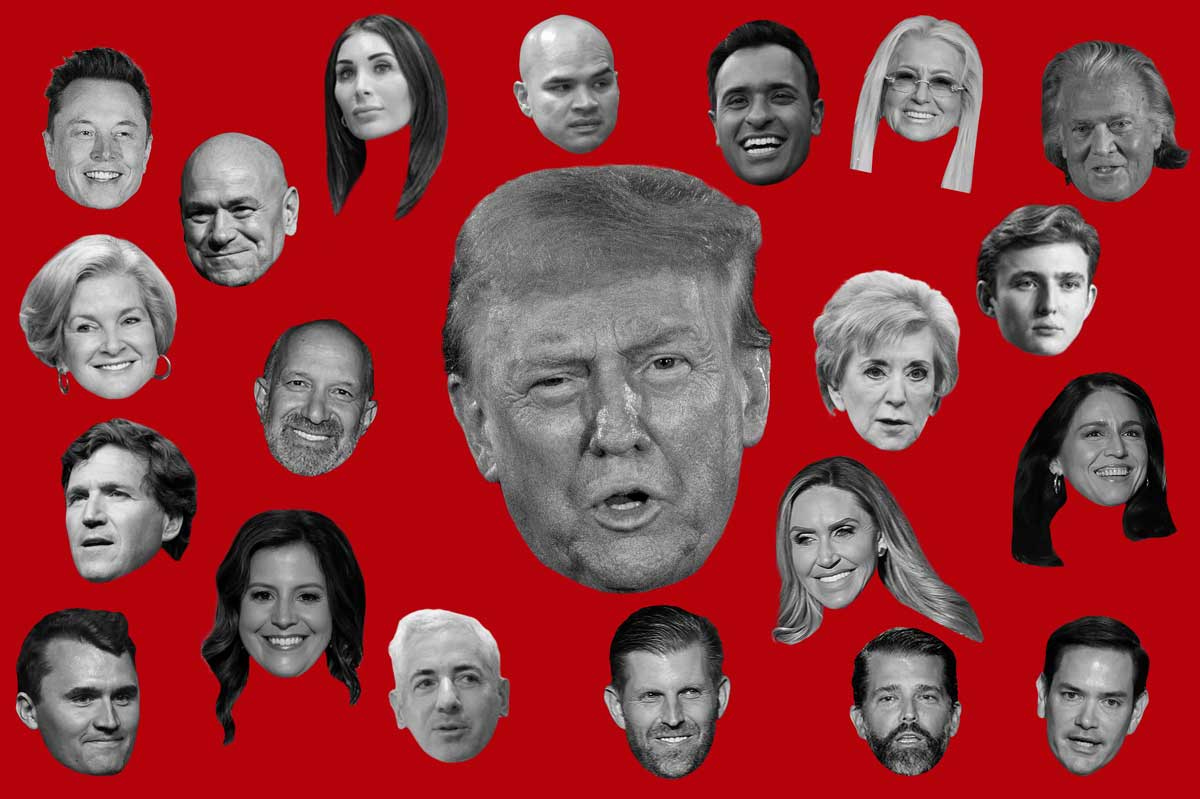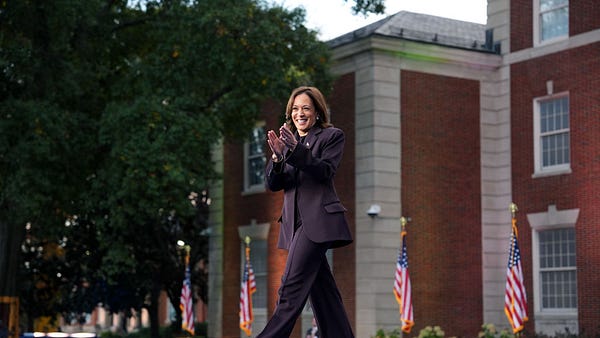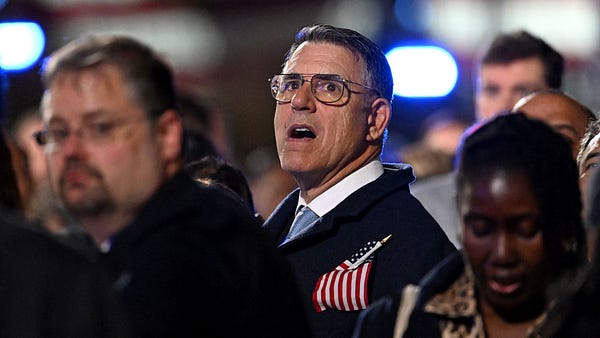
The Free Press

After years of struggling with depression and anxiety, Stephania Messina, 39, a pediatric respiratory therapist from Clinton Township in Detroit’s northern suburbs, found God.
That led her to Donald Trump.
She and her husband, Dan, joined a local evangelical church. Messina was a registered independent who had canvassed for Barack Obama in college. In the 2020 election, though, Messina, like other members of her church, saw Trump as a man of God—someone who, despite his wealth, could have had a life of ease, but instead chose to fight for the American people.
“We saw Trump as a persecuted hero, who was here to save the country,” Messina told me.
But the church’s full-throated support for the events of January 6, 2021, deeply troubled her.
“Some of the people involved in the January 6 rioting were from my church. For them, the Bible was above the Constitution,” she said. So in 20 days, she’ll cast her vote for Kamala Harris.
In a presidential race as tight as this one, any voter’s conversion could be significant, especially in Michigan, one of a half-dozen swing states that will decide the election. Messina’s disenchantment is even more noteworthy because it is part of a small but detectable drop in support for Trump in a crucial voting bloc: white women.
White women are the largest demographic in the electorate, making up 41 percent of registered voters. Trump narrowly won this group over Hillary Clinton in 2016 and more comfortably over Joe Biden in 2020.
The latest Pew Research Center poll of registered voters shows Trump leading Harris 50 to 45 percent nationally among white women. But if his numbers drop even a percentage point or two in this huge cohort of voters, that could be the difference on November 5. So it’s no coincidence that Trump will hold a town hall Wednesday on issues affecting women before an audience of women.
The numbers in Michigan have to worry the Trump campaign. A pollster who conducted Tuesday’s AARP Research poll told The Free Press that 52 percent of likely female voters support Harris compared to 42 percent for Trump.
Compare that to 2016, when 52 percent of white women in Michigan voted for Trump as opposed to 43 percent for Clinton. In 2020, exit polling in the state showed 51 percent of white women voted for Trump compared to 49 percent for Biden.
Amy Tarkanian, 47, from Nevada, is another woman in a battleground state who should worry the Trump campaign.
She previously served as chair of the Nevada Republican Party and was a delegate for Trump in 2016. Her husband is a Republican county commissioner. “We finally had a fighter in Trump, somebody who was going to speak up and fight for us,” she told me about her attitude then.
Despite voting for Trump twice, she has now decided she will no longer support him.
“There was a volcano effect of things that were just piling up for me. And finally the eruption for me was on January 6 and Trump’s lack of response to that event to this day as he continues to spew the lies of the election being stolen,” Tarkanian said.
“I think he seems to enjoy chaos, and I’m tired of it. If Vice President Harris ends up being an extension of the Biden administration, well then, so be it,” she added.
Nevada has gone Democratic in the last four elections—although the margins have been getting smaller.
An American Greatness/TIPP Poll, conducted between September 23–25, found 47.1 percent of white women in Nevada preferred Harris compared to 43.9 percent who said they were likely to vote for Trump.

In North Carolina, another swing state, Jenny Patterson also found herself changing her mind about Trump. Patterson, 51, a massage therapist currently pursuing a graduate degree in physical therapy, lives near Charlotte. She voted for Trump in 2016 but by 2020, she had soured on him.
“I did not like Trump’s handling of Covid. I did not like his combativeness, how much he took to Twitter to stir up people. He seems to get enjoyment from getting people riled, and that is not what I want in a president. I saw too much divisiveness and chaos,” Patterson said.
Patterson told me she was “relieved” when Biden dropped from the race and Harris became the Democratic presidential candidate.
“Kamala is not my first choice either, but she is a better candidate than Trump,” she said. “She is an accomplished woman, so I feel more comfortable with her than I do with Trump.”
Even so, Trump maintains a comfortable lead among white women in the state. Data shared with The Free Press from a survey released September 30 by the Center for Survey Research at East Carolina University show that Trump leads among white women who are likely voters, 61 percent to 35 percent.
Donna Harris Redick, 63, lives in Tennessee, which isn’t likely to swing Democratic this election. But she tells a similar story of why she changed her mind.
“You assume your president is going to be a man. I don’t think we were ready for a woman president,” she said, explaining why she didn’t support Clinton in 2016.
Indeed, Clinton has blamed white women for abandoning her and leading to her election defeat, citing double standards.
“They left me because they just couldn’t take a risk on me, because as a woman, I’m supposed to be perfect,” Clinton told The New York Times earlier this year.
Redick voted for Trump again in 2020, but is now backing Kamala Harris. She told me that her previous votes were a “poor decision.” The pivotal moment for her in turning against Trump were the events surrounding January 6.
“What a mistake I had made thinking Trump would be loyal to our Constitution,” she said.
Harris’s nomination energized Redick.
“Kamala rose up like a phoenix, and I think she really tapped into all of us that we were just really wanting Trump to go away,” she told me.
In Pennsylvania, another battleground state, Trump appeared to be badly underwater with white women just a month ago. Harris led by a whopping 14 percentage points, an increase over her 10-point lead in August. But things are now turning Trump’s way. A recent Quinnipiac poll shows Trump leading Harris by one percentage point among white women. And an American Greatness/TIPP Poll conducted October 7–9 has him leading by three percentage points (49.3 to 46.5) among likely white women voters.
So perhaps the conversion process is incomplete. But for some, there’s no going back.
“When I saw our democracy and Constitution were at stake on January 6, that there was no peaceful transfer of power, I felt guilty. I can’t believe I got fooled,” Redick told me.
Whether or not Michigan votes for Trump, Messina has left both her church and Trump behind.
“I drank the Trump Kool-Aid, the whole two liters of it. I feel guilt and remorse for having voted for Trump,” she told me.
“I am part of the reason we’re in this divisive mess today, because I voted for him. My vote caused harm and I really believe I need to make amends.”
Rupa Subramanya is a reporter for The Free Press. Follow her on X @rupasubramanya and read her piece, co-written with Olivia Reingold and Francesca Block, “They’re Voting for Trump to ‘Save Democracy’.”
To support The Free Press, become a subscriber today:














I have never liked Trump's combative, name-calling behavior, he comports himself poorly and is certainly partly responsible for the breakdown in civility in the country, nor do I approve of his Jan 6 behavior. I never thought that I would vote for him, but I have to say that is I balance out all of the other issues now facing the US, out-of-control illegal immigration, inflation ushered in by Harris' tie-breaking vote, this administration's deplorable treatment of our ally and the only democracy in the the MIddle East who we said we had their back, period, stop, the horrendous use of DEI, the riots on our campuses and streets, an increasingly bellicose Russia, China, North Korea, the weapoization of the DOJ, I am willing to swallow hard and vote for the Republicans, not Trump per se. Abortion is not dead, it has been returned to the States and we women can work to get it enshrined in the Constitution where Ruth Bade Ginsburg thought it should be - Equal Rights not Privacy. IMO, this election cannot be a single issue election. There is too much at stake, and Harris, IMO has shown she is not up to the job, she can't even explain the specifics of her platform beyond vague statements for the most part. She is not ready for the job.
White woman from Georgia, voted for Trump in 2016 because I thought a businessman would have sense enough to balance the budget, and I intensely disliked Hillary. In 4 years, despite some progress on the economy, he did nothing to balance the budget and I came to intensely dislike Trump because of the chaos. His lack of character was just something I couldn’t overlook anymore. As a result, I have become politically homeless. I threw away my vote on Libertarian Jorgensen in 2020 - the Biden/Trump choice to me was worse than Biden/Harris. Now that Biden has been put out to pasture, I’m voting for Harris. Jan. 6 was the final straw. I’ve had 4 years to let that fade away but every time he opens his mouth, he sounds like a fascist. The nationalism, the anti-migrant rhetoric, his persecution complex and plans for revenge, and recently the military against the “enemy within” crap - good Lord. 😡
So I’m more determined than ever to vote for Harris, even though I disagree with most of her her economic policies. I trust her slightly more on Israel, I’m pro-choice, and those are probably my tipping points away from a throw-away vote. I did not trust Biden on Israel and let’s face it - Trump is just lying about his support for Israel and abortion. He will reverse course for his alt-right anti-semites as soon as he is elected - they know it and we know it. I have slightly more faith in Kamala, maybe simply because she’s married to a Jewish man. And maybe Kamala will stop yapping about Roe and do something that is actually sensible - like a federal statutory solution.
I gave Trump a chance and I regret it. I will give Kamala a chance this year. I may regret it but Trump is just not an option.